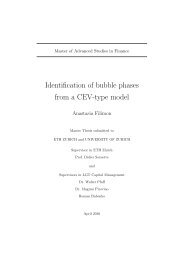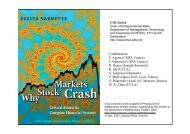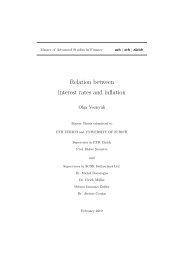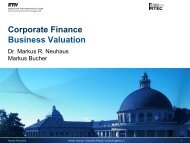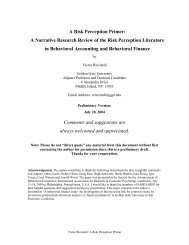Tail Dependence - ETH - Entrepreneurial Risks - ETH Zürich
Tail Dependence - ETH - Entrepreneurial Risks - ETH Zürich
Tail Dependence - ETH - Entrepreneurial Risks - ETH Zürich
Create successful ePaper yourself
Turn your PDF publications into a flip-book with our unique Google optimized e-Paper software.
3.17 Relative deviations between coefficients of upper and lower tail dependence<br />
estimated by the non-parametric approach of Sornette & Malevergne<br />
using ˆ β calculated for the whole sample and ˆ βSI calculated for the<br />
tail according to three different conditions for index S&P 500 and the<br />
nine assets. The tail represents the most extreme 4 % of data during<br />
a smaller time interval ranging from January 1991 to December 2000<br />
(k = 100) and during a bigger time interval ranging from July 1985 to<br />
Mars 2008 (k = 229). * denotes zero values of tail dependence calculated<br />
by ˆ βSI, ’NaN’ denotes 0/0, and ’inf’ denotes ·/0. . . . . . . . . . . . . . 76<br />
3.18 Results for ˆ βSI using the first SI condition: Y ≥ Y (k) ∩ X ≥ X(k) and<br />
the second SI condition: Y ≥ Y (k) for upper and lower tails calculated<br />
by least squares method applied on linear additive single factor model:<br />
X = β · Y + ε and for resulting upper and lower tail dependence coefficients<br />
ˆ λ + and ˆ λ− with corrected ˆl (c . . .k) and uncorrected ˆl (1 . . .k).<br />
The tail represents the most extreme 4% of data during a time interval<br />
ranging from January 1991 to December 2000 (k = 100, c = 13). *<br />
denotes ˆ β < 0 → λ = 0. . . . . . . . . . . . . . . . . . . . . . . . . . . . 77<br />
3.19 Results for ˆ βSI using the first SI condition: Y ≥ Y (k) ∩ X ≥ X(k) and<br />
the second SI condition: Y ≥ Y (k) for upper and lower tails calculated<br />
by least squares method applied on linear additive single factor model:<br />
X = β · Y + ε and for resulting upper and lower tail dependence coefficients<br />
ˆ λ + and ˆ λ− with corrected ˆl (c . . .k) and uncorrected ˆl (1 . . .k).<br />
The tail represents the most extreme 4% of data during a time interval<br />
ranging from July 1985 to Mars 2008 (k = 229, c = 29). * denotes<br />
ˆβ < 0 → λ = 0. . . . . . . . . . . . . . . . . . . . . . . . . . . . . . . . 78<br />
3.20 Establishing the uncertainty of non-parametrically estimated upper and<br />
lower tail dependence coefficients ˆ λ by creating 1000 bootstrap samples<br />
of historical return data tables for S&P 500 index and corresponding<br />
asset returns and calculation of quantiles, extreme values, and standard<br />
deviations of the results. The tails represent the most extreme 4% (excluding<br />
highest 0.5% for λc) of the return values during a time interval<br />
from January 1991 to December 2000. ˆ βj have been calculated on the<br />
first SI condition: Y ≥ Y (k) ∩ X ≥ X(k). ’inf’ denotes ·/0. . . . . . . . 95<br />
3.21 Establishing the uncertainty of non-parametrically estimated upper and<br />
lower tail dependence coefficients ˆ λ by creating 1000 bootstrap samples<br />
of historical return data tables for S&P 500 index and corresponding<br />
asset returns and calculation of quantiles, extreme values, and standard<br />
deviations of the results. The tails represent the most extreme 4% (excluding<br />
highest 0.5% for λc) of the return values during a time interval<br />
from July 1985 to Mars 2008. ˆ βj have been calculated on the first SI<br />
condition: Y ≥ Y (k) ∩ X ≥ X(k). ’inf’ denotes ·/0. . . . . . . . . . . . 96<br />
3.22 Establishing the uncertainty of non-parametrically estimated upper and<br />
lower tail dependence coefficients ˆ λ by creating 1000 bootstrap samples<br />
of historical return data tables for S&P 500 index and corresponding<br />
asset returns and calculation of quantiles, extreme values, and standard<br />
deviations of the results. The tails represent the most extreme 4% (excluding<br />
highest 0.5% for λc) of the return values during a time interval<br />
from January 1991 to December 2000. ˆ βj have been calculated on the<br />
second SI condition: Y ≥ Y (k). ’inf’ denotes ·/0. . . . . . . . . . . . . 97



